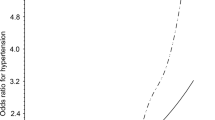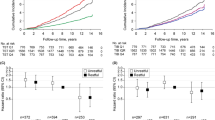Abstract
Objective:
Several epidemiologic, longitudinal studies have reported that short sleep duration is a risk factor for the incidence of obesity. However, the vast majority of these studies used self-reported measures of sleep duration and did not examine the role of objective short sleep duration, subjective sleep disturbances and emotional stress.
Design:
Longitudinal, population-based study.
Subjects:
We studied a random sample of 815 non-obese adults from the Penn State Cohort in the sleep laboratory for one night using polysomnography (PSG) and followed them up for a mean of 7.5 years. Subjective and objective measures of sleep as well as emotional stress were obtained at baseline. Obesity was defined as a body mass index (BMI) ⩾30 kg/ m-2.
Results:
The incidence of obesity was 15% and it was significantly higher in women and in individuals who reported sleep disturbances, shorter sleep duration and higher emotional stress. Significant mediating effects showed that individuals with subjective sleep disturbances who developed obesity reported the shortest sleep duration and the highest emotional stress, and that subjective sleep disturbances and emotional stress were independent predictors of incident obesity. Further analyses revealed that the association between short sleep duration, subjective sleep disturbances and emotional stress with incident obesity was stronger in young and middle-age adults. Objective short sleep duration was not associated with a significantly increased risk of incident obesity.
Conclusion:
Self-reported short sleep duration in non-obese individuals at risk of developing obesity is a surrogate marker of emotional stress and subjective sleep disturbances. Objective short sleep duration is not associated with a significant increased risk of incident obesity. The detection and treatment of sleep disturbances and emotional stress should become a target of our preventive strategies against obesity.
This is a preview of subscription content, access via your institution
Access options
Subscribe to this journal
Receive 12 print issues and online access
$259.00 per year
only $21.58 per issue
Buy this article
- Purchase on Springer Link
- Instant access to full article PDF
Prices may be subject to local taxes which are calculated during checkout


Similar content being viewed by others
References
Ogden CL, Carroll MD, Kit BK, Flegal KM . Prevalence of obesity in the United States, data from the National Health and Nutrition Examination Survey, 2009–2010. United States Department of Health and Human Services. Centers for Disease Control and Prevention. National Center for Health Statistics. NCHS Data Brief 2012; 82: 1–8.
Zalesin KC, Franklin BA, Miller WM, Peterson ED, McCullough PA . Impact of obesity on cardiovascular disease. Med Clin North Am 2011; 95: 919–937.
Nielsen LS, Danielsen KV, Sørensen TI . Short sleep duration as a possible cause of obesity: critical analysis of the epidemiological evidence. Obes Rev 2011; 12: 78–92.
Magee L, Hale L . Longitudinal associations between sleep duration and subsequent weight gain: a systematic review. Sleep Med Rev 2012; 16: 231–241.
Lauderdale DS, Knutson KL, Rathouz PJ, Yan LL, Hulley SB, Liu K . Cross-sectional and longitudinal associations between objectively measured sleep duration and body mass index: the CARDIA sleep study. Am J Epidemiol 2009; 170: 805–813.
Vgontzas AN, Lin HM, Papaliaga M, Calhoun S, Vela-Bueno A, Chrousos GP et al. Short sleep duration and obesity: the role of emotional stress and sleep disturbances. Int J Obes (Lond) 2008; 32: 801–809.
Bixler EO, Vgontzas AN, Lin HM, Vela-Bueno A, Kales A . Insomnia in Central Pennsylvania. J Psychosom Res 2002; 53: 589–592.
Bixler EO, Vgontzas AN, Ten Have T, Tyson K, Kales A . Effects of age on sleep apnea in men: I. prevalence and severity. Am J Respir Crit Care Med 1998; 157: 144–148.
Bixler EO, Vgontzas AN, Lin HM, Ten Have T, Rein J, Vela-Bueno A et al. Prevalence of sleep-disordered breathing in women: effects of gender. Am J Respir Crit Care Med 2001; 163: 608–613.
Waksberg J . Sampling methods for random digit dialing. J Am Stat Assoc 1978; 73: 40–46.
Kish L . Survey sampling. John Wiley & Sons, Inc: New York, 1965.
Rechtschaffen A, Kales A . A manual of standardized terminology, techniques and scoring system for sleep stages of human subjects. National Institutes of Health: Bethesda, MD, 1968.
Butcher JN, Graham JR, Ben-Porath YS, Tellegen A, Dahkstrom WG . MMPI-2: manual for administration, scoring and interpretation. revised edition. University of Minnesota Press: Minneapolis, MN, 2001.
U.S. Department of Health and Human Services (DHHS), National Center for Health Statistics. Third National Health and Nutrition Examination Survey, 1988-1994. NHANES III laboratory data file. Centers for Disease Control and Prevention: Hyattsville, MD, 1996.
Appelhans BM, Janssen I, Cursio JF, Matthews KA, Hall M, Gold EB et al. Sleep duration and weight change in midlife women: the SWAN sleep study. Obesity (Silver Spring) 2013; 21: 77–84.
Vgontzas AN, Tsigos C, Bixler EO, Stratakis CA, Zachman K, Kales A et al. Chronic insomnia and activity of the stress system: a preliminary study. J Psychosom Res 1998; 45: 21–31.
Vgontzas AN, Bixler EO, Lin HM, Prolo P, Mastorakos G, Vela-Bueno A et al. Chronic insomnia is associated with nyctohemeral activation of the hypothalamic-pituitary-adrenal axis: clinical implications. J Clin Endocrinol Metab 2001; 86: 3787–3794.
Bonnet MH, Arand DL . Hyperarousal and insomnia: state of the science. Sleep Med Rev 2010; 14: 9–15.
Bonnet MH, Arand DL . Insomnia, metabolic rate and sleep restoration. J Intern Med 2003; 254: 23–31.
Singareddy R, Vgontzas AN, Fernandez-Mendoza J, Liao D, Calhoun S, Shaffer ML et al. Risk factors for incident chronic insomnia: a general population prospective study. Sleep Med 2012; 13: 346–353.
Fernandez-Mendoza J, Vgontzas AN, Bixler EO, Singareddy R, Shaffer ML, Calhoun SL et al. Clinical and polysomnographic predictors of the natural history of poor sleep in the general population. Sleep 2012; 35: 689–697.
Gold PW, Chrousos GP . Organization of the stress system and its dysregulation in melancholic and atypical depression: high vs low CRH/NE states. Mol Psychiatry 2002; 7: 254–275.
Dallman MF, Pecoraro N, Akana SF, la Fleur SE, Gomez F, Houshyar H et al. Chronic stress and obesity: a new view of ‘comfort food’. Proc Natl Acad Sci USA 2003; 100: 11696–11701.
Vgontzas AN, Bixler EO, Tan TL, Kantner D, Martin LF, Kales A . Obesity without sleep apnea is associated with daytime sleepiness. Arch Intern Med 1998; 158: 1333–1337.
Bixler EO, Vgontzas AN, Lin HM, Calhoun SL, Vela-Bueno A, Kales A . Excessive daytime sleepiness in a general population sample: the role of sleep apnea, age, obesity, diabetes and depression. J Clin Endocrinol Metab 2005; 90: 4510–4515.
Panossian LA, Veasey SC . Daytime sleepiness in obesity: mechanisms beyond obstructive sleep apnea-a review. Sleep 2012; 35: 605–615.
Ong CW, O'Driscoll DM, Truby H, Naughton MT, Hamilton GS . The reciprocal interaction between obesity and obstructive sleep apnoea. Sleep Med Rev 2012; 17: 123–131.
Basta M, Vgontzas AN . Metabolic abnormalities in obesity and sleep apnea are in a continuum. Sleep Med 2007; 8: 5–7.
Morin CM, LeBlanc M, Daley M, Gregoire JP, Mérette C . Epidemiology of insomnia: prevalence, self-help treatments, consultations and determinants of help-seeking behaviors. Sleep Med 2006; 7: 123–130.
Vgontzas AN, Fernandez-Mendoza J, Liao D, Bixler EO . Insomnia with objective short sleep duration: the most biologically severe phenotype of the disorder. Sleep Med Rev 2013; 17: 241–254.
Morin CM, Bélanger L, LeBlanc M, Ivers H, Savard J, Espie CA et al. The natural history of insomnia: a population-based 3-year longitudinal study. Arch Intern Med 2009; 169: 447–453.
Vgontzas AN, Fernandez-Mendoza J, Bixler EO, Singareddy R, Shaffer ML, Calhoun SL et al. Persistent insomnia: the role of objective short sleep duration and mental health. Sleep 2012; 35: 61–68.
Acknowledgements
The work was performed at the Sleep Research & Treatment Center of the Penn State University Milton S. Hershey Medical Center and the staff (C Criley and P Cain) is especially commended for their efforts. This research was in part funded by the National Institutes of Health grants R01 51931, R01 40916 and R01 64415.
Author information
Authors and Affiliations
Corresponding author
Ethics declarations
Competing interests
The authors declare no conflict of interest.
Rights and permissions
About this article
Cite this article
Vgontzas, A., Fernandez-Mendoza, J., Miksiewicz, T. et al. Unveiling the longitudinal association between short sleep duration and the incidence of obesity: the Penn State Cohort. Int J Obes 38, 825–832 (2014). https://doi.org/10.1038/ijo.2013.172
Received:
Revised:
Accepted:
Published:
Issue Date:
DOI: https://doi.org/10.1038/ijo.2013.172
Keywords
This article is cited by
-
Nonrestorative sleep is a risk factor for metabolic syndrome in the general Japanese population
Diabetology & Metabolic Syndrome (2023)
-
Associations of multiple sleep dimensions with overall and abdominal obesity among children and adolescents: a population-based cross-sectional study
International Journal of Obesity (2023)
-
Daily partner responsiveness and everyday sleep outcomes in breast cancer survivors and their partners
Supportive Care in Cancer (2022)
-
Adaptive Solutions to the Problem of Vulnerability During Sleep
Evolutionary Psychological Science (2022)
-
Gender differences in the association between sleep duration and body mass index, percentage of body fat and visceral fat area among chinese adults: a cross-sectional study
BMC Endocrine Disorders (2021)



